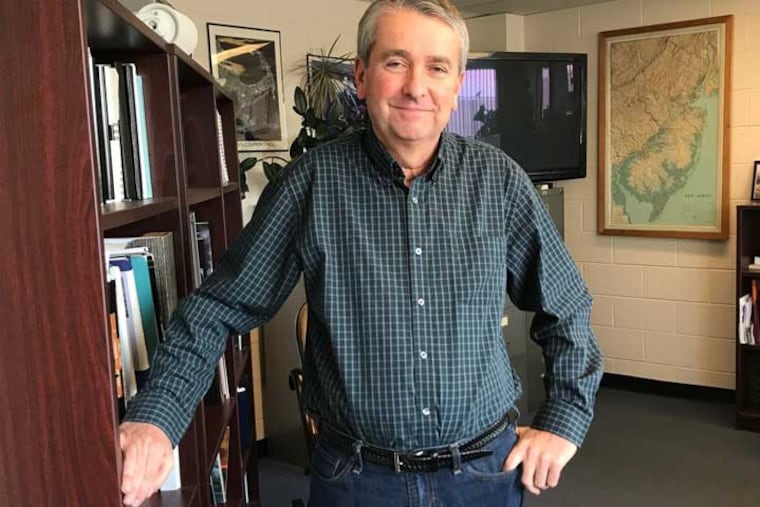Will it ever snow again? Should we be worried? Yes and yes, says New Jersey’s international snow expert.
A Q&A with David A. Robinson, the nation’s longest-serving state climatologist and the impresario of the 30-year-old Rutgers University Global Snow Lab.

PISCATAWAY, N.J. — This has been one brutal winter — at least for a snow-lover and cross-country ski enthusiast like David A. Robinson. Yet he still feels like he’s someone with a dream job, like covering the ice-cream beat at the local newspaper.
He has a lifelong fascination with snow, or dating to age 5, anyway. And, as it turned out, snow has been a nexus of his career. Robinson, a professor of geography and the nation’s longest-serving state climatologist, is the impresario of the 30-year-old Rutgers University Global Snow Lab, and his research efforts would explain how this unlikely venue in central New Jersey has become a snow research center.
These days, you might think that looking for snow would be about as exciting as studying flood potential in the Mojave. But it is snowing somewhere, and Robinson’s Snow Lab publishes daily reports of how much of the Earth’s surface is covered by snow in the Northern Hemisphere.
» READ MORE: Philly’s nearly snowless winter: How it compares to previous snow-deprived seasons
He drifted into this snow business while at Columbia University for graduate school in the 1980s, when he became a student of snow mapping. His mentors included Wallace Broecker, whose research spurred the 2004 climate-fiction disaster movie about a mighty big chill The Day After Tomorrow, and NASA scientist James Hansen, an early global-warming siren-sounder.
Robinson has published numerous papers and is a contributor to reports published by the Intergovernmental Panel on Climate Change. Snow is a critical climate indicator. It’s a refrigerant and effective solar-energy repellent.
On yet another day unfit for cross-country skiing in Piscataway, he shared his thoughts on his research and the future of snow as we know it.
Your data date to 1967. Does anyone else have an archive that goes back that far?
“This product is the longest consistent satellite environmental data record.”
You published your first paper on snow cover 30 years ago. Was that a breakthrough?
“No one had really looked at snow extent. … We discovered the decline in spring snow extent. The decline didn’t begin until the mid- to late 1980s. We even talked about the possibility of climate change.”
You now have better data and redigitized charts. Did you have issues with what you were looking at back then?
“We realized there was an inconsistency with the way NOAA [National Oceanic and Atmospheric Administration] generated their numbers. It didn’t change the results, but it altered the database.… We were getting leftovers.… So we figured out what the problem was and then generated a database that was consistent.”
What was NOAA’s reaction?
“I became established as the go-to person … even within NOAA.… That inconsistency by NOAA was the best thing that ever happened to me, at least in terms of recognition for my snow science endeavors. I’ve ridden that sled ever since.”
What have you seen that has surprised you?
“For the last 11 years, October and November snow extent has been rather dramatically increased.”
Really? Isn’t the planet getting warmer?
“It seems to be associated with high pressure in the Arctic in the fall. The jet stream may be dipping into the continents. Melting in the Arctic may be changing the circulation pattern.”
But the winter snow extent has been about normal, according to your charts, even in this snow-deprived winter.
“We’re seeing a greater change in snow depth in some areas; for example, the central United States.”
» READ MORE: Ten years ago, Philly got 44 inches of snow in 5 days. Why this winter is so different.
Why should anyone care about how much snow is on the ground?
“Snow in one sense is the great integrator because it involves temperature and precipitation. Snow has a critical role in climate change.… A huge fraction of the world’s population relies on snowfall for their drinking water and irrigation water.”
Computer models, and recent evidence, suggest that a warmer world is going to be a wetter one. Isn’t water water?
“You’re losing that icy reservoir.… The water is not being held by the snowpack. Water is going to run downstream in January, February, and March, and we’re going to have to be prepared for that.”
Are you saying that we might see the end of snow?
“It will continue snowing.… There’s potential for a lot more moisture in the air.… One could hypothesize larger snowstorms when all the stars align.… Maybe the smaller snowstorms will be less frequent.”
» READ MORE: No one lives at the airport. So why is Philly’s snowfall measured there?
So how would one know when the end is near?
“One has to be very patient.… Snow observations at the surface haven’t been nearly as good as they’ve been with temperature and precipitation.… Satellites don’t to a good enough job of observing snow depth. Snowfall exhibits considerably more year-to-year variability than temperature and precipitation. It’s going to take a long time for a statistically significant signal to emerge from a very noisy snow signal.”